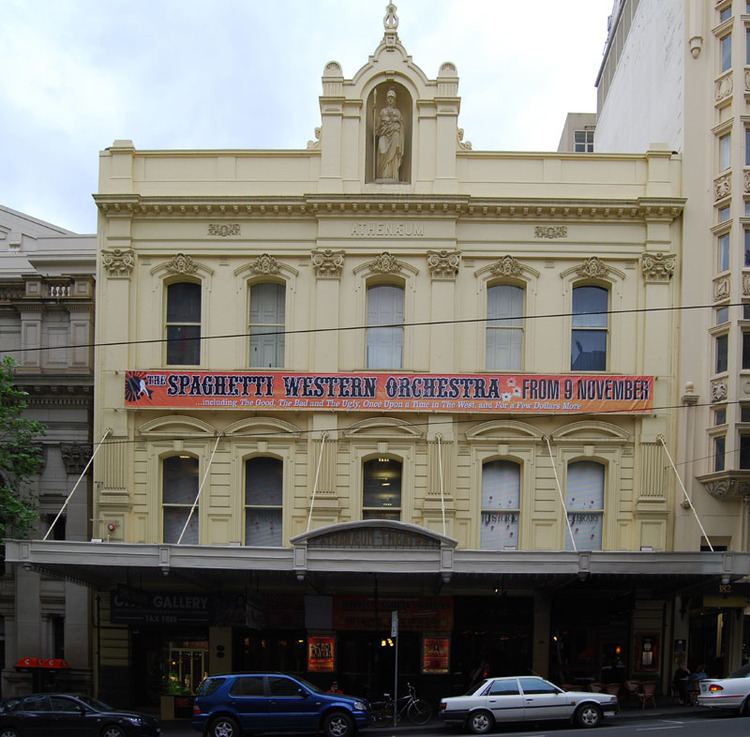Opened 1839 Years active 177–178 Capacity 880 (theatre one) | Rebuilt 1885-1886 Architect Smith & Johnson Phone +61 3 9650 1500 | |
 | ||
Current use Live theatre, comedy, library, readings Similar Regent Theatre - Melbourne, Her Majesty's Theatre, Capitol Theatre - Melbourne, Comedy Theatre - Melbourne, Princess Theatre - Melbourne | ||
The Athenaeum or Melbourne Athenaeum is one of the oldest public institutions in Victoria, Australia, founded in 1839. Its building in the Melbourne City Centre consists of a main theatre hosting a range of theatre, comedy and music performances, a small studio theatre, and a subscription library. The building was added to the National Trust's Register of Historic Buildings in 1981 and is listed on the Victorian Heritage Register. The theatre is part of Melbourne's East End Theatre District.
Contents
Early history
The first President was Captain William Lonsdale, the first Patron was the Superintendent of Port Philip, Charles La Trobe and the first books were donated by Vice-President Henry Fyshe Gisborne. Originally called the Melbourne Mechanics' Institute, it was renamed in 1846 to the Melbourne Mechanics' Institution and School of Arts.
The building at 188 Collins Street was completed in 1842. The Melbourne City Council met in the building until 1852 when the Melbourne Town Hall was built.
The Institution changed its name to the Melbourne Athenaeum in 1872. At that time, as now, a focal point was the library. In 1877, membership was 1,681 and in 1879 there were 30,000 visits to the library. In 1880 it was reported 'that the floor of the large hall was the only one in Melbourne expressly constructed for dancing'. The front of the building was rebuilt in 1885 and 1886.
Theatre and cinema
In October 1896, the first movie was shown in Australia in the Athenaeum Hall. The Hall became a regular venue for screening films and the premiere of The Story of the Kelly Gang by the Tait brothers, the world's first dramatic feature film, was at the Athenaeum in 1906.
The theatre in its present form, a proscenium arch theatre with 880 seats on three levels, was created in 1924. It was the first venue in Australia to screen talking pictures, presenting The Jazz Singer in February 1929. From the 1920s to the early 1970s, the theatre was mainly used as a cinema for British films. The Melbourne Theatre Company (MTC) leased the theatre from 1976 to 1985 when the lease was taken over by various entrepreneurs who formed AT Management in 1997.
The upstairs studio theatre ("Ath 2"), created from the former art gallery by the MTC, has been used as a theatre space and the venue for The Last Laugh Comedy Club after it moved from North Melbourne.
Art gallery
The Athenaeum housed a small museum in its early days and then an art gallery. The gallery hosted the first exhibition of Frederick McCubbin's The Pioneer in 1904. The gallery also showed paintings by Rupert Bunny, Hans Heysen, Albert Namatjira, Tom Roberts, John Rowell, Constance Stokes and Arthur Streeton, before closing in 1971. The gallery also hosted talks by the Melbourne Society of Women Painters, including one in 1935 at which Mary Cecil Allen spoke.
Subscription library
Membership of the Athenaeum's subscription library peaked at 7,579 in 1950, after the State Library of Victoria ceased lending of its books in 1939.
Today
Today, the Athenaeum Theatre is used for a range of theatre, comedy and music performances, including as a principal venue for the Melbourne International Comedy Festival and Melbourne Opera. The Wheeler Centre for Books, Writing and Ideas presents discussions and talks at the theatre. The Hillsong Church also uses the theatre for its Sunday services.
The subscription library has a 30,000-strong collection and hosts regular events, talks, book clubs and a screen club.
Melbourne Athenaeum is not related to the nearby Athenaeum Club.
